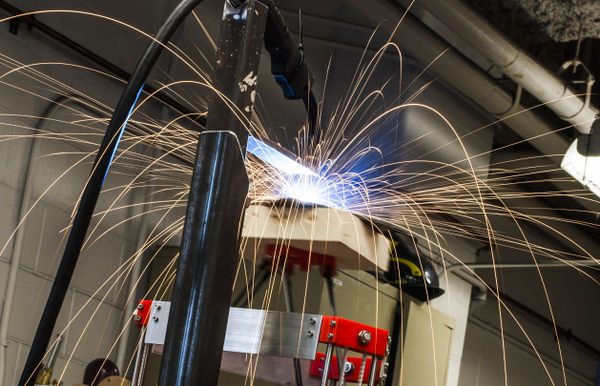MTU Advances Inexpensive Metal Additive Manufacturing

Sparks fly from MTU’s new low-cost metal 3D printer. Courtesy of MTU.
Latest News
December 9, 2013
Concerns about the role of additive manufacturing (AM) and firearms continues to grow by degrees. Philadelphia recently became the first city to ban 3D printed guns, and a few voices in the US government are calling for increased regulation on the types of weapons that can be produced through AM. The bright spot in this gloom had been that any gun built with a 3D printer would be made of plastic, and, as a result, wasn’t very reliable.
That isn’t to say metal AM systems can’t make firearms. Solid Concepts proved this point not long ago by building a 1911 pistol using 3D printed parts. The average price for a metal AM system kept this from becoming much of an issue. Would-be terrorists aren’t likely to spring for a half million dollar machine to build guns when buying them is easier and less expensive. That paradigm may be shifting again with Michigan Technological University’s (MTU) new metal 3D printer, which can be constructed for under $1,500.

MTU’s research team, led by Joshua Pearce, has managed to cobble together what could be thought of as the RepRap of metal AM. Using a mix of off-the-shelf parts and reproducible materials, including a MIG welder and stepper motor, MTU’s new system is entirely open source, including online documentation. Pearce’s goal is for others to improve upon his model, bringing the cost of metal AM systems more in line with their plastic material counterparts.
“Similar to the incredible churn in innovation witnessed with open-sourcing of the first RepRap plastic 3D printers, I anticipate rapid progress when the maker community gets their hands on it,” said Pearce, an associate professor of materials science and engineering/electrical and computer engineering. “Within a month, somebody will make one that’s better than ours, I guarantee it.”
While it might eventually be possible to build a gun using the system, currently it’s a bit primitive for such complex designs. Nor is MTU unaware of the less savory uses for 3D printing. Following the first round of dismay over 3D printed guns, the university sponsored a “3D Printers for Peace” contest to highlight the good that can come from universal access to AM.
Pearce has also authored a study about the costs of 3D printing replacement parts for home users, compared to buying new parts outright. MTU, and its staff, are interested in what 3D printing can do to improve life.
“I really don’t know if we are mature enough to handle it,” he added cautiously, “but I think that with open-source approach, we are within reach of a Star Trek-like, post-scarcity society, in which ‘replicators’ can create a vast array of objects on demand, resulting in wealth for everyone at very little cost. Pretty soon, we’ll be able to make almost anything.”
Below you’ll find a short video about 3D printing at MTU.
Source: MTU
Subscribe to our FREE magazine, FREE email newsletters or both!
Latest News
About the Author
John NewmanJohn Newman is a Digital Engineering contributor who focuses on 3D printing. Contact him via [email protected] and read his posts on Rapid Ready Technology.
Follow DE





